Following on my initial foray into photographing landscapes while I was in Shikoku in May, I spent the first half of June in Iceland with fellow photographer Jon Cornforth, looking for opportunities to take landscape images (and also taking puffin pictures). We spent most of the time chasing pockets of light all over the country, racking up over 3200km of road by the time we were done.
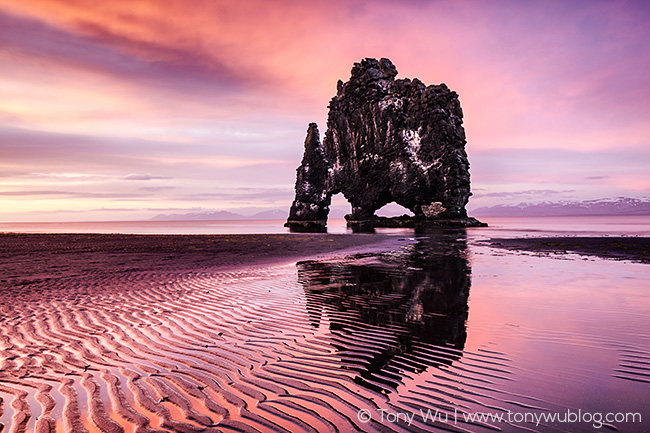
I use the term "chasing" because that's exactly what we were doing. It was overcast during much of our stay in Iceland. Grey can make for dark, moody, monotone shots, but that's not why we flew to the other side of the planet. We wanted spectacular light, like in the photo above of Hvítserkur, sometimes referred to as the Troll Rock.
So...with eyes glued to the weather forecast, we pretty much threw all best-laid plans out the window and went wherever it seemed like there might be a break in the clouds, driving south, then north, then east, then west, over and over and over.
Even with such flexible plans, we only managed to hit pay dirt a few times. At Hvítserkur, we stood out in the cold for about six hours. The light you see pictured above lasted a minute. Maybe.
I learned a lot from spending time with Jon, a talented and accomplished photographer.
For instance, I learned that there's a lot of waiting involved with landscapes, in both the passive sense (sitting some place hoping the light will do something interesting) and the active sense (checking the weather forecast, driving every which way at all hours of the day and night, calculating and anticipating angles of light).
Not that this was a big surprise. Waiting is certainly a factor with underwater photography, such as when I'm trying to take photos like this:
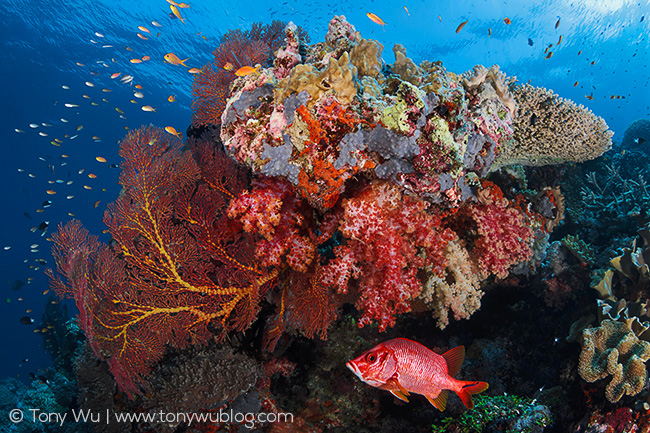
But on land, it's different.
When I'm in the water, time is limited. Scuba generally gives me 45 minutes to 1.5 hours, sometimes longer if it's shallow and I'm not moving much. With a rebreather, my potential stay lengthens to three to five hours. Still, there's a point at which I've got to head back up. Below the surface, I'm usually alone. There's no one to talk with, so I carry on conversations with myself, with bewildered fish, with whatever swims my way.
In contrast, endurance and patience were our only real limits in Iceland. Plus, the ability to talk was a novelty.
We talked about a lot of things, though you might be surprised at how infrequently topics related to photography came up. Sure, when the time came to settle in and get serious about triggering the shutter, we exchanged thoughts about perspective, settings, timing, etc., but for the most part, we conversed about current events, social trends, politics, etc.
We were (mostly) cut off from the internet and other outside interference, so it was the perfect opportunity to really talk, really listen, really spend time thinking. It reminded me of the good old days, before instant communication and the expectation of instant response permeated our existence.
The fact that I've maintained a consistent presence online for almost a decade should demonstrate that I'm not a Luddite by any means, but still, being disconnected for a couple of weeks was refreshing.
It was nice mainly because I got to know Jon really well. We've been friends for six years or so, but think of it this way: When is the last time you had an opportunity to spend 24/7 with a friend for two weeks, with nearly no interruption from emails, phone calls, etc., with the opportunity to chat and explore issues in depth...with discussions spanning many hours spread out over days?
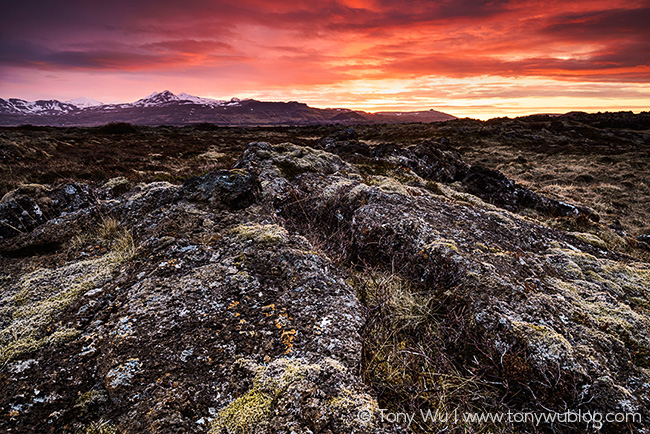
In between talks and lots of wandering around, we stumbled into a few excellent photo opportunities. The scene above, for example, materialised out of nowhere. We had just dropped off a couple of hitchhikers, Dutch and German female geology students hiking and camping their way around Iceland, when the sky clouded up, then turned brilliant shades of red, orange, and purple. It was dark, cold and drizzly, and we had to schlep gear through excrement-laden fields (lots of cute but poop-prone sheep in Iceland). It was all a bit of a confused rush. I'm still not sure how I managed to get a decent photo in the chaos.
Shortly thereafter, we made it to a well-photographed place, Kirkjufellsfoss waterfall on the Snaefellsnes Peninsula. We actually got lost and headed the wrong way at first, but fortunately corrected course in time to pull up a little before sunrise:
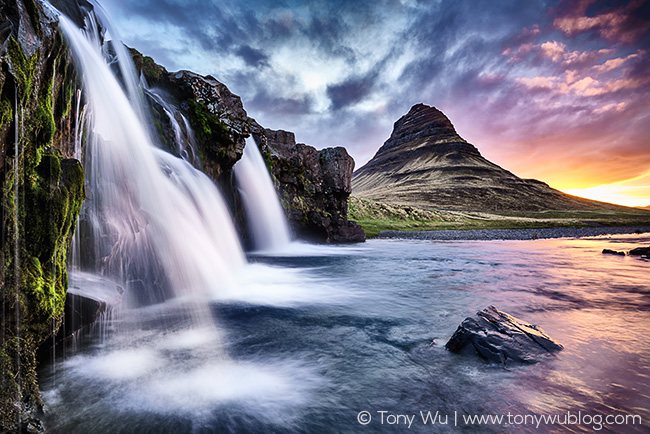
I've said this before, but it bears repeating: Light is everything to photography.
After getting the photo above, for instance, I was ready to pack it in. The sky had grown dull, and it was cold(!). But Jon, having substantially more experience than I do with this type of photography, thought it wise to wait. About half an hour later, golden light broke through a hole in the clouds and hit the waterfall just so. Just perfectly so.
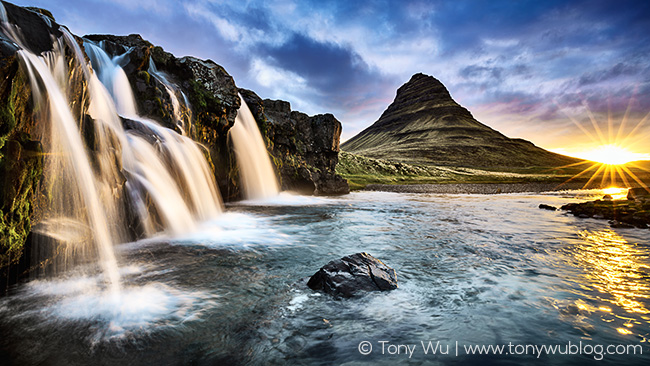
Incidentally, if you're interested, I used a Sony a7r for these landscape photos. In the past year or two, I've been using an assortment of cameras: Canon, Nikon, Olympus, Sony. Each brand and camera model has pros and cons. I've found it advantageous (though a logistical nightmare) to make use of the best tool for the purpose at hand. In this case, the dynamic range and sharpness of the a7r defy belief. The main drawback of the camera is the user interface, which is clunky at best. I get around this by shooting in Manual mode, with manual focus. I just worry about setting shutter, aperture and ISO. In short, I pretty much just use it as I would a manual film camera, with the addition of a nice articulating LCD screen to aid with composition.
I did experience one problem with the a7r while I was in Iceland. It started giving me an error message quite early in the trip. The message, in Japanese below, basically says: "Camera error. Turn power off and on." (For some reason, Sony cameras sold in Japan are only enabled for Japanese language. You can't change the user language in the camera menu, as you can with every other brand.)
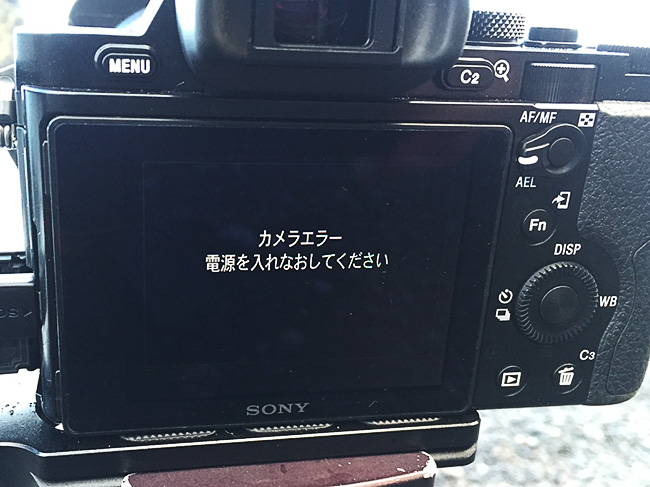
I did as instructed. Removing the battery entirely and then replacing it solved the problem the first few times, but eventually the shutter just refused to work. Or more accurately, it only worked about once out of every 50 attempts. Less than ideal for landscape photography with ever-changing light conditions.
I took the camera in to the service center when I got back to Japan. It was diagnosed with a faulty shutter charging mechanism, which cost me a couple hundred dollars to replace. In case you have a Sony camera and experience this...I searched the internet and saw that other people have experienced the problem, with the error message appearing in English as: Camera error turn power off then on.
The camera seems to be working fine now. It's light and small enough that I'll be taking it with me on upcoming trips.
After Iceland, we traveled to Svalbard, where we spent two weeks with more friends, seeing lots of ice, sunlight 24/7, walruses, polar bears, bearded seals and more. I'll post more photos if I can get my act together in the next few days.